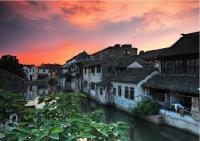Upper Huayan Temple
The Upper Huayan Temple is one of the parts of Huayan Temple. Situated in the southwest of Datong City, Huayan Temple is one of the biggest temples in China built in Liao Dynasty. The Huayan Temple was divided into two parts: The Upper Huayan Temple and Lower Huayan Temple which has their own entrance and architecture respectively and were renovated and enlarged several times to its present form. In 1963, the two separated temple were connected together as a whole and named Huayan Temple.

The Upper Huayan Temple was characterized by a rang of gorgeously decorated buildings, The whole Upper Huayan Temple comprises of two yards, the temple gate, the passing hall, the Kwan-yin Pavilion, the Ksitigarbha Pavilion, and two wing-bays, etc.
The biggest and most illustrious building is the Grand Hall (Daxiong Bao Dian), the main hall of the Upper Temple. The Grand Hall stands on a 4-meter-high platform surrounded by handrails. It is 9-bay wide and 5-bay long, occupying an area of more than 1,550 square meters. All the doors have a single-eaved hip roof, which peacefully reach out to a length of 3.6 meters. 12 pillars inside were removed so that the space was enlarged and the hall could be more convenient for performing rituals. On the central altar inside, there are five statues of Buddha, three of which in the middle were made in Beijing City in second year of the Xuande reign in the Ming Dynasty. These statues have a flat face, and their buns are decorated with pearls. 20 attendants, with different expressions and postures, stand leaning a bit forward. Such special modeling is rater rare in China.

The ceiling of the hall, delicately decorated with a variety of color-murals of dragons and phoenix, floras, Sanskrit Buddhist symbols and other geometric patterns, creates a rich visual feast for eyes. The wall around is covered with frescoes of the Qing Dynasty. The frescoes are 6.4 meters high, with an area of 88,700 square meters. It is quite rare to have such a great painting on a single wall in China. The contents are about biography of Sakyamuni, illustrating the texts of Buddhism, guardian warriors and Kwan-yin with thousands of hands and eyes, etc. the main colors are blue and green, gorgeous and bright.












